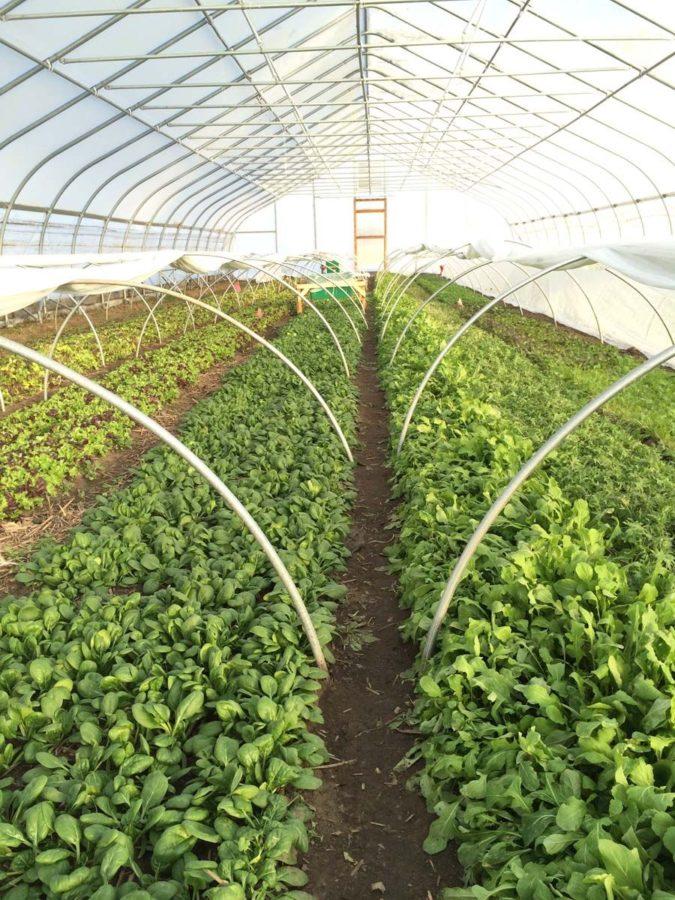Sustainable Student Farm grows year-round
October 22, 2014
At its intersection with South Windsor Road, Lincoln Avenue turns into a gravel driveway that leads to barns, sheds and a fenced-in seven-acre area of plots full of rows of plants. With only a few greenhouse frames and various crops outside, the Sustainable Student Farm is so much more than what it appears.
“The main purpose of the SSF is to be a seasonal produce farm that sells produce strictly to the dining halls,” said Zack Grant, manager and farm director of the SSF. Grant, along with Bruce Branham and Wes Gerald, played a key role in the birth of the farm back in 2009.
The established relationship between the SSF and University Dining formed when Bruce Branham, professor of Crop Sciences, and Dawn Aubrey, associate director of Housing for Dining, had a conversation about sustainable food production.
“It only seemed logical to have produce that was produced locally, which also achieved our academic mission,” Aubrey said. “I think it’s just another form of education. It gives us an opportunity to support the academic mission and also educate our students about sustainability. By 2050, it is estimated that we will not have enough protein to supply the growing population, so we have something called Be-Flexitarian; having one meal a week that is vegetarian and vegan.”
Grant said from a consumer standpoint, this farm is a great way to show individuals that it is possible to grow different types of produce year-round if one uses the techniques and systems demonstrated by SSF.
Get The Daily Illini in your inbox!
One technique that is new to SSF during the colder months is high tunnel production, which they are transitioning into this month.
“When you look at it, the first thing most people say is, ‘Oh that’s a greenhouse.’ It can be, but it is a passively solar-heated greenhouse. This means that there is no heat input or cooling involved in it,” Grant said. “It’s a steel structure with plastic covering, and you’re creating microclimates.”
The high tunnels are connected to a moveable track so it can be rolled from one plot to another. This gives shelter to the crops that can no longer survive outside and can then thrive during whichever microclimate the high tunnels create.
For the winter, as the normal outdoor production is coming to an end, the SSF begins to plant winter-sustainable crops, such as salad greens and root crops. As it continues to get colder, the high tunnels protect these crops from exposure through winter, which allows SSF to continue supplying produce to University Dining.
During the winter months, most farms are unable to produce any type of crop, but the high tunnel protection allows the farm to harvest all the way through Christmas break and February.
“After Christmas break, we’re really into the winter months, and at that point, most farmers are doing nothing. For us, if crops like spinach and kale grow nicely, we can then harvest what is still harvestable in the middle of winter,” Grant said. “Even in January, we can bring produce to dining, replant the same set again and have a second set ready for March.”
The ability to supply fresh produce 12 months out of the year allows the SSF to supply one to five percent of produce to all of University Dining.
Carrie Anderson, executive chef for Residential Dining, feels that SSF has majorly impacted dining and the University.
“It has strengthened our partnership with ACES, which has opened other doors for collaboration efforts on campus, serving local produce from farm to table,” Anderson said.
In addition to producing high quantities of produce for University Dining, the farm is also consistently researching better ways to achieve harvestable produce during the winter months. This includes successfully transitioning into different seasons.
The Farm also sells extra produce on the Main Quad every Thursday from 11 a.m. to 5 p.m., May through November.
Having the ability to harvest year-round also allows students to have continuous options for volunteering.
The farm welcomes all volunteers Monday through Friday from 8:30 a.m. to 4 p.m.
Tess O’Leary, sophomore in DGS, heard about the farm from her art professor, Steve Kostell, who makes paper out of prairie grasses, corn and soy.
“I volunteered on the farm because I love plants and have always been very into the environmental movement,” O’Leary said.
After volunteering on the farm, O’Leary felt she gained a better idea about what it takes to grow her own food and the methods used to promote sustainable food growth.
“Not enough people recognize the perpetuated habits that degrade our very planet and take action to change our unhealthy behaviors,” she said. “The education is prevalent, but the action is limited.”
Frances can be reached at [email protected].







